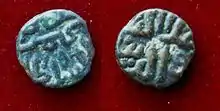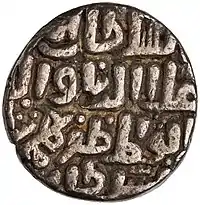Ala-ud-Din Bahman Shah
Ala-ud-Din Hasan Bahman Shah (Persian: علاء الدين بهمن شاه; died 10 February 1358)[4] whose original name was Zafar Khan or Hasan Gangu, was the founder of the Bahmani Sultanate.
| Ala-ud-Din Bahman Shah | |||||
|---|---|---|---|---|---|
| Ala-ud-Din Hasan Bahman Shah | |||||
 | |||||
| 1st Sultan of the Bahmani Sultanate | |||||
| Monarch | 3 August 1347 – 10 February 1358 | ||||
| Successor | Mohammed Shah I | ||||
| Born | Zafar Khan 1290-1292[1][2] | ||||
| Died | 10 February 1358 (aged 65–66)[3] | ||||
| Burial | |||||
| Issue | Sultan Muhammed Shah I, Prince Mahmud, Prince Dawood | ||||
| |||||
Ancestry and early life

According to Gordon Kerr and Andre wink, Zafar Khan was of Afghan origin.[5][6] Mughal-era historian Ferishta states that Zafar Khan's origins are too obscure to be traced, but places him as of Afghan origin,[7][8] while Herman writes that Zafar Khan was a Turk or an Afghan of unknown descent.[9] Richard Eaton identifies the descendants of families who migrated to the Deccan with part-Turkish ancestry as North Indian immigrants that spoke an early form of Hindavi or Urdu.[10]
Nothing can be traced definitively in the early history of Hasan Gangu, the founder of the dynasty because of the obscurity of his background, except that he was of humble origin.[11][12][13] Historians have not found any corroboration for the legend,[14][15] but Barani, a contemporary of Hasan Gangu as the court chronicler of Sultan Firuz Shah, as well as some other scholars have also corroborated his surname as Gangu, which points out his Hindu cognomen.[16][17] His ancestry is known, but detractors inspired by the prejudices of the partisan advocate of the Adil Shahi dynasty have claimed that his ancestry is unknown.[18][19] Furthermore, there is a legend regarding him narrated by the 17th century poet Ferishta,[20] which says that he was a servant of a Brahmin astrologer named Gangu of Delhi and he was himself called Hasan Gangu. Historians have not found any corroboration for the legend, but Barani also corroborates the fact that Alauddin's original name was Hasan Gangu.[14][15][21] Ferishta mentions that later poets "who wanted to flatter him" called Hasan Gangu a descendant of Bahman, but considers it implausible.[22] It is possible that Bahman is a corrupted persianized form of Brahman,[23] and Hassan Gangu might have been born as a Hindu.[24][25]
In 1339, Zafar Khan participated in an uprising against the Tughluqs. This turned out unsuccessful; he and his allies were exiled to Afghanistan the same year. He managed to return to the Deccan, and in 1346 he participated in a siege of Gulbarga, at the time under Tughluq control. The siege proved successful.[26]
He was made a governor. Zafar Khan rose to power during the Rebellion of Ismail Mukh and In 1347 he was made commander of an army in Daulatabad. On 3 August 1347, the Afghan noble Nasir-ud-Din Ismail Shah, also known as Ismail Mukh, whom the rebel amirs of the Deccan placed on the throne of Daulatabad in 1345) abdicated in favor of Zafar Khan, resulting the establishment of the Bahmani Kingdom with its headquarters at Hasanabad (Gulbarga).[27][28][29] He was in charge of a three city Jahangir, with his main rule at Miraj.[30]
Reign
Upon establishing an independent kingdom, Zafar Khan took the title of Abu'l-Muzaffar Ala-ud-din Bahman Shah.[29][21] He gave Ismail Mukh a jagir near Jamkhandi and later conferred to him the highest title of his kingdom, Amir-ul-Umara. But Narayana, a local Hindu chieftain still succeeded in turning Ismail against Bahman Shah for a short period before he poisoned Ismail.[31]
Bahman Shah led his first campaign against Warangal in 1350 and forced its ruler Kapaya Nayaka to cede to him the fortress of Kaulas. His kingdom was divided into four provinces and he appointed a governor for each province.[31] During his reign Hasan fought many wars with Vijayanagara. By the time of his death the kingdom stretched from north to south from the Wainganga River to Krishna and east to west from Bhongir to Daulatabad.[32]
He was succeeded by his son Mohammed Shah I after his death in 1358.[32]
References
- Sherwani 1946, Alauddin Hassan Shah Bahamani pp.69.
- history of the decan. Mittal Publications. 1990. p. 15.
This man was called Hasan. He was born in the year 1290 (A.D.) and was in very humble circumstances.
- Briggs 1909, Death of Alauddin Hassan Shah Bahamani pp. 297.
- Shokoohy, Mehrdad (ed.), "Alauddin Hassan Shah Bahamani", Encyclopædia Iranica
- Kerr, Gordon (2017). A Short History of India: From the Earliest Civilisations to Today's Economic Powerhouse. Oldcastle Books Ltd. p. 160. ISBN 9781843449232.
In the early fourteenth century, the Muslim Bahmani kingdom of the Deccan emerged following Alauddin's conquest of the south. Zafar Khan, an Afghan general and governor appointed by Sultan Muhammad bin Tughluq, was victorious against the troops of the Delhi Sultanate, establishing the Bahmani kingdom with its capital at Ahsanabad (modern-day Gulbarga).
- Wink, Andre (1991). Indo-Islamic society: 14th - 15th centuries. BRILL. p. 144. ISBN 9781843449232.
- Scott, Jonathan (2016). Ferishta's History of Dekkan from the first Mahummedan conquests: with a continuation from other native writers, of the events in that part of India, to the reduction of its last monarchs by the emperor Aulumgeer Aurungzebe: also, the reigns of his successors in the empire of Hindoostan to the present day: and the history of Bengal, from the accession of Aliverdee Khan to the year 1780. hansebooks. p. 15. ISBN 9783743414709.
Some Authors write that he was descended from Bahman, one of the ancient kings of Persia. And I have seen a pedigree of him, fo derived (?), in the royal library of Ahmednagar: but am inclined to believe, such lineage was only framed upon his accession to royalty, by flatterers and poets, and that his origin is too obscure to be authentically traced. The apellation of Bahmani, he certainly took in compliment to Kango Brahmin, which is often pronounced Bhamen, and by tribe he was an Afghan.
- Wink, André (2020). The Making of the Indo-Islamic World C.700-1800 CE. Cambridge University Press. p. 87. ISBN 9781108417747.
- Kulke & Rothermund 2004, p. 181: "The Bahmani sultanate of the Deccan Soon after Muhammad Tughluq left Daulatabad, the city was conquered by Zafar Khan, a Turkish or Afghan officer of unknown descent, had earlier participated in a mutiny of troops in Gujarat."
- Richard M. Eaton (2005). A Social History of the Deccan, 1300-1761 Eight Indian Lives · Part 1, Volume 8. p. 69.
- Anthony Hearle Johns, Raphael Israeli, Yohanan Friedmann (1984). Islam in Asia: South Asia.
man of humble origin
{{cite book}}: CS1 maint: multiple names: authors list (link) - Chopdar. History and Culture of the Indian People, Volume 06,The Delhi Sultanate. p. 248.
- Scott, Jonathan (2016). Ferishta's History of Dekkan from the first Mahummedan conquests: with a continuation from other native writers, of the events in that part of India, to the reduction of its last monarchs by the emperor Aulumgeer Aurungzebe: also, the reigns of his successors in the empire of Hindoostan to the present day: and the history of Bengal, from the accession of Aliverdee Khan to the year 1780. hansebooks. p. 15. ISBN 9783743414709.
Some Authors write that he was descended from Bahman, one of the ancient kings of Persia. And I have seen a pedigree of him, fo derived (?), in the royal library of Ahmednagar: but am inclined to believe, such lineage was only framed upon his accession to royalty, by flatterers and poets, and that his origin is too obscure to be authentically traced. The apellation of Bahmani, he certainly took in compliment to Kango Brahmin, which is often pronounced Bhamen, and by tribe he was an Afghan.
- Chandra 2004, p. 177.
- Majumdar 1967, p. 248.
- The Dacca University Studies: Volumes 1-2. the University of Dacca. 1935. p. 139.
- Chopdar. History and Culture of the Indian People, Volume 06,The Delhi Sultanate. Bharatiya Vidya Bhavan. p. 248.
- Avari 2013, p. 88.
- Kulke & Rothermund 2004, p. 170.
- Briggs 1909, Alauddin Hassan Shah Bahamani pp. 284-285.
- Bhattacharya 1972, p. 100.
- Prashad, Baini (1939). The Tabaqat-i-akbari Of Khwajah Nizamuddin Ahmad Vol.iii. Banasthali. p. 3.
- Uppe, Dr Shivakumar V. (30 July 2022). BRIEF CULTURAL HISTORY OF BASAVAKALYANA. Ashok Yakkaldevi. ISBN 978-1-387-84786-0.
- Suvorova (2000). Masnavi. p. 3. ISBN 978-0-19-579148-8.
- Husaini (Saiyid.), Abdul Qadir (1960). Bahman Shāh, the Founder of the Bahmani Kingdom. Firma K.L. Mukhopadhyay. pp. 59–60.
- M., Eaton, Richard. A Social History of the Deccan, 1300-1761 : Eight Indian Lives. pp. 40–42. ISBN 978-1-139-05390-7. OCLC 921054505.
{{cite book}}: CS1 maint: multiple names: authors list (link) - Ahmed Farooqui, Salma (2011). Comprehensive History of Medieval India: From Twelfth to the Mid-Eighteenth Century. Pearson. p. 150. ISBN 9789332500983.
- Mahajan, V.D. (1991). History of Medieval India, Part I, New Delhi:S. Chand, ISBN 81-219-0364-5, pp.279–80
- Bhattacharya. Indian History. p. 928
- Proceedings, Indian History Congress (Part 2 ed.). Indian History Congress. 2007. p. 1443. Retrieved 4 June 2019.
- Majumdar 1967, pp. 249–250.
- Bhattacharya. Indian History. p. 929
Sources
- Avari, Burjor (2013), Islamic Civilization in South Asia: A history of Muslim power and presence in the Indian subcontinent, Routledge, ISBN 978-0-415-58061-8
- Bhattacharya, Sachchidananada (1972), A Dictionary of Indian History, Westport: Greenwood Press
- Chandra, Satish (2004), Medieval India: From Sultanat to the Mughals-Delhi Sultanat (1206–1526) – Part One, Har-Anand Publications, ISBN 978-81-241-1064-5
- Kulke, Hermann; Rothermund, Dietmar (2004), A History of India (Fourth ed.), Routledge, ISBN 9780415329194
- Majumdar, Ramesh Chandra (1967), The Delhi Sultanate, Bharatiya Vidya Bhavan
- Briggs, John, ed. (1909), History of the Mohommedan powers in india till 1612,Vol 2
- Sherwani, H K, ed. (1946), History of the Bahmani dynasty-An Objective study